60 mm Cage Cube for Fluorescence Filter Sets
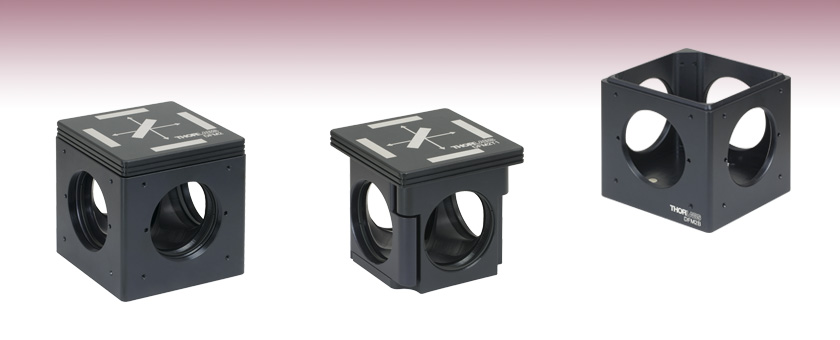
- Quickly Interchange Filter Sets with Repeatable Alignment
- Mounts Ø2" Round Optics and 50.8 mm x 72.0 mm Rectangular Optic
- 60 mm Cage System and Ø2" Lens Tube Compatible
DFM2
60 mm Cage Cube for Fluorescence Filter Sets, SM2-Threaded Ports
DFM2T1
Separate Inserts Available for
Easy Exchange of Optics
DFM2B
Kinematic Cage Cube Base

Please Wait
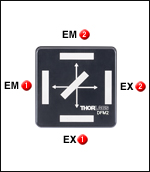
Click to Enlarge
The DFM2 has two excitation (EX) and two emission (EM) filter ports. Ports labeled with the same number should be used together.
Features
- Kinematic 60 mm Cage Cube for Holding Fluorescence Filter Set (Not Included)
- 60 mm Cage System and SM2 (2.035"-40) Lens Tube Compatible
- Two Emission Ports with 3° Tilt to Reduce Undesired Reflections
- Individual Cube Insert, Base, and Cover Plate Also Available
- 60 mm Cage Cube Connector for Connecting Two Cubes Side by Side (Sold Separately Below)
- Compatible with 60 mm Right-Angle Optic Cage Cube Systems
The DFM2(/M) Fluorescence Filter Cube is designed to hold a fluorescence filter set (dichroic mirror, excitation filter, and emission filter) in a cage-system-compatible cube for home-built microscopy setups. It consists of a post-mountable base and removable insert that accepts filter set components. The cube insert is magnetically retained in the cube base, allowing for repeatable insertion in an aligned setup. Additional inserts are available to easily exchange alternate sets of optics within an aligned setup. This enables the user to switch between fluorescence imaging of different wavelengths.
As shown in the animation to the right, the insert is designed to hold a rectangular optic, such as a dichroic mirror, beamsplitter, or silver mirror. The rectangular optic is clamped gently in place using a leaf spring that provides a uniform holding force to minimize stress. To mount the rectangular optic, remove the leaf spring using a Phillips #00 screwdriver and then insert the optic with the reflective coating face down. Only light force is needed to prevent the optic from moving; we recommend screwing in both screws most of the way before final tightening.
In addition, the cube insert has four ports for Ø50 mm filters. Excitation and emission filters can be mounted in two possible configurations (see the diagram to the right) and are held using the included SM2RR Retaining Rings, which can be tightened or loosened with our SPW604 Spanner Wrench (sold separately). The emission ports (see photo to the right) are oriented at a 3° angle with respect to the face in order to reduce undesired reflections. To help keep track of your filter sets, spaces are provided on the top to write labels for the mounted filters and mirrors. The cube insert is designed to be inserted in a single orientation with respect to the cube base, so it is important to orient the full cube assembly in the proper direction within the setup.
The base of these kinematic cubes has an SM2-threaded (2.035"-40) port on each face at an optical height from the base of 1.75" and 45 mm for the imperial and metric versions, respectively. These ports are compatible with our SM2 lens tubes. Four 4-40 tapped holes surround each port for compatibility with our 60 mm cage system. The cube base is equipped with three bottom-located 1/4"-20 (M6) tapped holes, which provide direct compatibility with our Ø1" posts or Ø1.5" posts. Alternately, an AE8E25E (AE4M6M) thread adapter (sold separately) can be used for compatibility with our Ø1/2" posts.
| # | Product Description | Qty. | Photo (Click to Enlarge) |
|---|---|---|---|
| 1 | DFM1 - Kinematic Fluorescence Filter Cube |
1 |  |
| 2 | Microscopy Filters | 1 Set |  |
| 3 | SM1B3 - Lens Tube Bellows | 1 |  |
| 4 | SM1ZM - Non-Rotating SM1 Zoom Housing |
1 |  |
| 5 | Focusing Lens Inside Zoom Housing |
1 |  |
| 6 | ST1XY-D - XY Translator with Differential Drives |
1 |  |
| 7 | Precision Pinhole Between XY Translator and Photodetector |
1 |  |
| 8 | Photodetector SM1-Compatible Photodetector |
1 |  |
DFM1 Filter Cubes - Optic Alignment in a Confocal Microscope Detection Module
The DFM1 is ideal for integrating filter sets into a custom microscopy setup. The following example of a partial confocal microscope uses a DFM1 Fluorescence Filter Cube (denoted by 1 in the image below) containing a Microscopy Filter Set (2) and an APD130A(/M) Photodetector (8). A lens (5) located inside the SM1ZM High-Precision Zoom Housing (4) focuses the beam onto a precision pinhole (7) located just before the avalanche photodetector's detector element. The SM1ZM zoom housing is mounted directly onto the ST1XY-D XY Translation Mount with Differential Adjusters (6), creating a compact XYZ mount. SM1 Lens Tubes and the SM1B3 Lens Tube Bellows (3) allow for a light-tight connection without inhibiting the free movement of the XYZ mount.
Components used in the configuration pictured below are listed in the table to the right. These parts, along with SM1 Lens Tubes and 1" Post Assemblies, are sold separately.
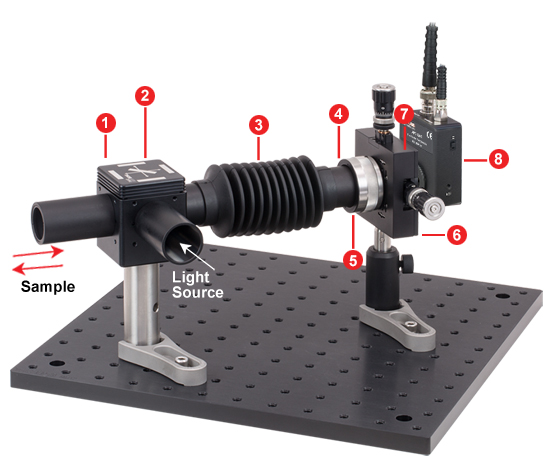
| Posted Comments: | |
user
(posted 2025-04-28 13:33:12.4) Are there any plans to make an SM3 version of this at some point? cdolbashian
(posted 2025-05-01 12:00:31.0) Thank you for reaching out to us with this inquiry. At this time we do not have a plan to make an SM3 version of this product. I have, however, suggested this within our internal product development forum for review. Perhaps it will be a "customer inspired" product in the future. Stefano Lettieri
(posted 2025-04-24 10:30:39.933) Dear Thorlabs Team,
I have the same question asked by other customers regarding the DFM2 cube and related optical components. I would like to use the 60 mm cage cube for fluorescence measurements in a setup using 2 inches optics. However, apparently there are no suitable dichroic optics and circular 2 inches bandpass filters to be mounted in the fluorescence cube.
Could you reach out to me and propose some possibile solutions? jdelia
(posted 2025-05-01 09:14:30.0) Thank you for reaching out. At this time, we do not offer filters/dichroics for this cube. I have reached out to you directly to discuss your application. Erik Frieling
(posted 2025-04-10 17:33:35.04) Do you sell dichroic mirrors of the correct size for DFM2 cube? cdolbashian
(posted 2025-05-01 11:28:33.0) Thank you for reaching out to us with this inquiry. While we do not sell these as catalog options, it is possible that we can cut these as a custom request. For such a customization please feel free to reach out directly to our solutions team: Techsales@thorlabs.com Drew Rone
(posted 2023-05-10 12:01:28.76) Do you sell dichroic mirrors of the correct size for DFM2 cube? jdelia
(posted 2023-05-11 01:49:21.0) Thank you for contacting Thorlabs. I have reached out to you directly to discuss your application. Xindong Song
(posted 2022-12-29 17:36:36.003) I seriously need DFM2L and DFM2LM to turn the beam left or right freely for my applications. Could you please make those models like what you did for the DFM1 series? Thank you. cdolbashian
(posted 2023-01-10 02:12:13.0) Thank you for your feedback Xindong! This is indeed a good idea, as we do not have both turning directions available to our 60mm filter cubes! I have submitted this to our internal product development forum for consideration! Michael Ashby
(posted 2021-01-25 11:17:19.767) Do you sell dichroic mirrors of the correct size for DFM2 cube? YLohia
(posted 2021-01-26 10:27:49.0) Thank you for contacting Thorlabs. I have reached out to you directly to discuss your application. Yuh-Jen Cheng
(posted 2020-07-29 05:22:40.91) Just curious. Is there really a difference between DFM1 and DFM1L? If I rotate DFM1 by 90 degrees, doesn't it become DFM1L? YLohia
(posted 2020-07-29 10:57:28.0) Hello, thank you for contacting Thorlabs. The cube insert is designed to be inserted in a single orientation with respect to the cube base, so it is not possible to simply rotate the insert by 90 degrees to obtain a 180 degree flip in the reflected beam path. We offer two versions due to a popular customer request for quick & easy switching of right or left orientations without disassembling the entire cage setup. Hazen Babcock
(posted 2020-03-09 10:43:19.273) It would be nice if you could make a version of this which had holes for the cage rods to go into. This would make it easier to join several of these together without needing lots of ERSCB adaptors. See for example KCB1 and KCB1C. YLohia
(posted 2020-03-10 08:36:10.0) Hello Hazen, thank you for your feedback. While the current design of the DFM1 filter cube does not have the required clearances for a Ø6 mm thru-hole for the cage rods, I have posted your request to our internal design forum for further consideration. lukas.hille
(posted 2018-06-25 14:25:22.08) Dear Thorlabs Team,
it would be nice, if the cube or an additional mount could hold 3mm thick dichroics. The quality of 3mm thick dichroics is supperior compared to 1 and 2mm.
I like this cube and its stability and flexibility.
best regards
Lukas YLohia
(posted 2018-06-25 09:37:44.0) Hello Lukas, the CM1-DCH allows for the mounting of dichroics up to 3mm thick. gregory.futia
(posted 2016-12-02 14:43:20.163) I designed a 3D printable storage box for the DFM1T1. The design files and STLs for printing are available on Thingverse.
http://www.thingiverse.com/thing:1923215 tfrisch
(posted 2016-12-05 01:19:05.0) Hello, thank you for your contribution on Thingiverse on behalf of our products. I hope our technical drawings were helpful in your application. dkleckner
(posted 2015-10-21 14:54:35.817) Could you please provide me with an estimated time-frame for the redesigned mount which would prevent overtightening? Will the new version share the same top half (so that it could be substituted later), or will both pieces be modified? besembeson
(posted 2015-10-26 10:08:28.0) Response from Bweh at Thorlabs USA: We don't have a firm release date yet but are working on this. I will follow-up with you. kyleh
(posted 2015-09-23 10:53:43.4) I am not convinced the little rubber pieces not causing distortion. I put my optic in, tightened it slowly and alternated sides, and it seemed fine at first. I put it back in the magnetic holder, and after about 15 minutes just sitting in the magnetic holder, it snapped my dichroic!! My dichroic is spec'd at 1.1 mm thickness as it says should work. It seems that sitting in the magnetic holder caused the holding to shift somehow? This is ridiculous!
There has to be a better way to hold the dichroics in place for this holder without breaking my optics or bending them to cause aberrations as others have commented on. besembeson
(posted 2015-10-07 10:32:15.0) Response from Bweh at Thorlabs USA: Thanks for the feedback. We are actually redesigning this mount that will prevent any over-tightening during assembly. I will be in contact with you once we release this. richard.j.smith
(posted 2015-08-17 04:22:31.287) similar to comment below from dfogletree, i would like a left handed filter holder to fit in the standard holder, so i can switch between two configurations in my instrument. is this part available yet? besembeson
(posted 2015-09-25 09:43:22.0) Response from Bweh at thorlabs USA: This part is not available yet. For now, the only option, which of course doesn't have all the advantages of the DFM is to use an a C6W or C4W with a B4C or B3C and an FFM1 or B5C that provides the freedom to set output orientation. dfogletree
(posted 2014-12-11 15:27:37.42) We are using the turning mirror and dichroic kinematic cubes, these are very useful for directing light to different detectors. However at the moment, as far as I know, there are only "right handed" parts. Once the base in built into an optical system, I would like to be able to put either a right or left mirror/dichroic in the base. This would let me built more flexible systems. Or there could be a method to convert right to left by unscrewing the parts -- at the moment the chirality seems to be fixed. cdaly
(posted 2014-12-18 04:26:48.0) Response from Chris at Thorlabs: Thank you for your feedback. We will discuss internally the possibility of adding another insert which can help steer the beam in the other direction without having to remount the cube entirely. dkleckner
(posted 2014-05-16 11:44:09.79) I'm having a similar problem as n-lindquist and syim regarding optical aberrations. I tested the holder and found that even applying a small amount of tightening force causes significant distortion with such thin optics. Is there any quick fix for this problem? I'm considering removing the rubber pieces and attaching the filter with optical epoxy, but this would limit the usefulness of the filter holder. besembeson
(posted 2014-05-21 04:25:05.0) A response from Bweh at Thorlabs in USA: Thanks for your feedback. It could be that you over-tighten the screws. The dichroic mirror is clamped in place using a design that provides uniform pressure without causing deformation to the mirror, and is locked in place using two 4-40 screws locked by a 3/32" hex key. Only light force is required to mount the filter. We recommend screwing in both screws most of the way before final tightening with a balldriver. Let me know if this helps nkaplin1
(posted 2013-09-03 14:48:31.513) Can you clarify the size of the dichroic that this cube will accept. It is listed as holding 25.2x35.6mm and 25x36mm in two places on the product page.
Will it accept the standard Zeiss and Nikon 25.5x36mm size? pbui
(posted 2013-09-09 10:32:00.0) Response from Phong at Thorlabs: Thank you for your post. The DFM cube should accept the standard Zeiss and Nikon size of 25.5 x 36 mm. If you have any further questions please contact Techsupport@thorlabs.com syim
(posted 2013-05-14 21:45:07.743) I have tried DFM/M for a home-built confocal microscopy. But I found my focused laser beam having severe aberrations. I believe the two small rubbers for dichroic beamsplitter give too much stress, since my collimated Gaussian beam turns to elliptical beam horizontally after about 50 cm. I tried my dichroic beamsplitter as well as a standard beamsplitter of Thorlabs (BSW20). My Nikon filter cube has no such problem (as you may know, it has a metal spring, instead of rubbers). jlow
(posted 2013-05-14 11:56:00.0) Response from Jeremy at Thorlabs: It could be that the screws are being over-tightened. You just need to have the screws in finger-tight (just enough to hold the optic in place). Also, it would be good to screw in both screws a considerable amount before the final tightening. I will contact you to discuss about this further. n-lindquist
(posted 2013-05-04 13:45:03.383) I am using a 1.1 mm thick "laser flat" dichroic filter and noticed that some significant astigmatism is introduced when mounted in this DFMT1 cube vs your standard cage-cube dichroic filter holders. Could the DFMT1 bend the dichroic at all? jlow
(posted 2013-05-09 16:43:00.0) Response from Jeremy at Thorlabs: The DFM shouldn't be bending your optic. I will contact you directly to look into this issue you are having. werley
(posted 2013-02-20 14:54:22.65) The magnetic filter cube is very convenient and we are hoping to use it in several home-built microscopes in the lab, but there are a couple issues. First, it would be great if the cube could accept slightly larger dichroics (26x38mm) that are standard in some Olympus filter cubes. This would facilitate interchange between different microscopes. We are hesitant to make the switch if we can't use any of the dichroics we already own.
Second, I don't like how the piece that unscrews from the DFMT1 to insert or remove the dichroic has a smaller clear aperture than standard for SM1. Could you not move the rubber cylinders so the press on the corners of the dichroic to fix it in place, and bore the holes out a bit further? Thanks. cdaly
(posted 2013-03-06 09:09:00.0) Response from Chris at Thorlabs: Thank you for using our web feed back. The DFM had been designed with the intention of keeping the product as compact as possible for use with our dichroic filters for fluorescence. I agree that this interoperability would be quite useful. I will bring up your recommendations in our internal forums and make sure that this is known to our engineers for possible revision. tcohen
(posted 2012-12-06 16:26:00.0) Response from Tim at Thorlabs: Thank you for your feedback! The DFM is designed to accept our line of fluorescence dichroics and our standard dichroic mirrors. For larger filters, we offer a solution with the use of either the CM1-DCH or the C4W with a B3C and FFM1. These have recently been updated to reduce deformation of the filter. seamus.holden
(posted 2012-11-27 13:39:45.043) I would very much like to use thicker dichroics (2mm) with this design. Thicker dichroics are very important for TIRF applications.
Has there been any progress on this? - I see that this issue was last raised in March. bdada
(posted 2012-04-23 16:48:00.0) Response from Buki at Thorlabs:
Thank you for your feedback. We are discussing your request with our production team and will post an update soon. user
(posted 2012-04-19 14:52:21.0) Limiting the dichroic thickness to only 1 mm really limits what filters you can use. Can the design be modified to support thicker filters? |
| Kinematic Cage Cubes Selection Guide (Click Image to Enlarge) | |||||
|---|---|---|---|---|---|
| Type | Empty Cubes for Fluorescence Filters |
Empty Cubes for Beamsplitters |
Empty Cubes for Right-Angle Optics |
Beam-Turning Cubes with Pre-Mounted Prism Mirrors | Multimode Fiber Optic Filter Cube |
| 16 mm Cage Cubes |  Full Web Presentation |
- | - | - | - |
| 30 mm Cage Cubes |   Full Web Presentation |
 Full Web Presentation |
 Full Web Presentation |
 Full Web Presentation |
 Full Web Presentation |
| 60 mm Cage Cubes |  Full Web Presentation |
- | 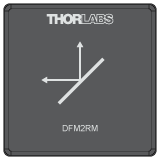 Full Web Presentation |
- | - |

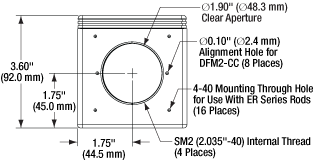
Click for Details
Drawing of DFM2(/M)
| DFM2(/M) Compatible Filters | ||
|---|---|---|
| Type | Dimensions | Thickness |
| Excitation | Ø50 mm | 9.0 mm |
| Emission | Ø50 mm | 6.0 mm |
| Dichroic | 50.8 mm x 72.0 mm | Min: 2.0 mm Max: 3.0 mm |
- Kinematic 60 mm Cage-Compatible Cubes for Mounting Fluorescence Filter Sets
- Four 4-40 Tapped Holes Around Each SM2-Threaded (2.035"-40) Port Enable 60 mm Cage System Compatibility
- Three Bottom-Located 1/4"-20 (M6) Tapped Holes for Post Mounting
The Kinematic Fluorescence Filter Cube for 60 mm Cage Systems consists of a post-mountable cube base and a removable insert that mounts a fluorescence filter set (not included).
See the table to the right for acceptable optic sizes. To see how to install optics in the filter cubes, please see the animation in the Overview tab above. Prior to mounting the rectangular dichroic mirror, please confirm that the optic is no greater than 3.0 mm thick.
The cube insert is designed to be inserted in a single orientation with respect to the cube base, so it is important to orient the full cube assembly in the proper direction.
All four sides of the filter cube base have an SM2-threaded port for compatibility with our Ø2" lens tubes. The SM2 port is centered between four 4-40 tapped holes for compatibility with Ø6 mm cage rods in a 60 mm cage system, at an optical axis height of 1.75" or 45.0 mm in the imperial or metric versions, respectively.
An empty kinematic filter cube insert, base, and cover plate are also sold separately below.

| DFM2T1 Compatible Filters | ||
|---|---|---|
| Type | Dimensions | Thickness |
| Excitation | Ø50 mm | 9.0 mm |
| Emission | Ø50 mm | 6.0 mm |
| Dichroic | 50.8 mm x 72.0 mm | Min: 2.0 mm Max: 3.0 mm |
- Empty Kinematic Base and Insert for Exchanging User-Provided Filters or Mirror
- Ideal for Quickly Switching Fluorescence Filter Sets or Angle of Reflection in an Aligned Experimental Setup
- Cube Base with Four 4-40 Tapped Holes Around Each SM2-Threaded (2.035"-40) Port
- Three Bottom-Located 1/4"-20 (M6) Tapped Holes for Post Mounting
- Cover Plate for Uninterrupted Beam Transmission Available
The Kinematic Fluorescence Filter Cube Insert (DFM2T1) and Base [DFM2B(/M)] are ideal for customers who wish to mount their own filter sets. Different filter sets can be loaded into the inserts, allowing for easy exchange of filter sets within an experimental setup (see image to the right). These items do not include fluorescence filters or a dichroic mirror.
See the table to the right for acceptable optic sizes. To see how to install optics in the cube, please see the animation in the Overview tab above. Prior to mounting the rectangular dichroic mirror, please confirm that the optic is no greater than 3.0 mm thick.
The cube insert is designed to be inserted in a single orientation with respect to the cube base, so it is important to orient the full cube assembly in the proper direction.
All four sides of the DFM2B(/M) cube base have an SM2-threaded port for compatibility with our Ø2" lens tubes. The SM2 port is centered between four 4-40 tapped holes for compatibility with Ø6 mm cage rods in a 60 mm cage system, at an optical axis height of 1.75" or 45.0 mm from the bottom of the imperial or metric cube, respectively.
For when a filter is not installed within the DFM2B(/M) cube base, we have the DFM2C Cage Cube Cover Plate to place on top. Additionally, we offer the SM2CP2 End Cap to minimize the amount of stray light entering through unused ports.

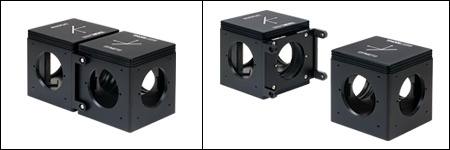
Click to Enlarge
Figure 664A Two 60 mm Cage-Compatible Beam Turning Cubes Connected Using the DFM2-CC Cage Cube Connector
- Connect Two 60 mm Cage-Compatible Beam Turning or Fluorescence Filter Cubes Side by Side
- Remove and Interchange Cube Inserts while the Cube Bases are Connected
- Eight 4-40 Screws (1/16" Hex) Included for Attaching Cage Cubes
The DFM2-CC Cage Cube Connector allows two kinematic 60 mm cage cubes to be connected together, as shown in Figure 664A. The connector is attached to the cage cubes using the eight included 4-40 screws (1/16" hex key included) in the cage rod holes. Two pins on the DFM2-CC are accepted by drilled holes on either side of any of the SM2-threaded (2.035"-40) ports on the cage cube faces to maintain alignment. Fluorescence filter and beam turning cube inserts can still be removed and inserted while the cube bases are connected.
 Products Home
Products Home
















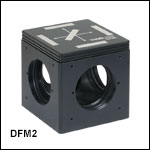
 Zoom
Zoom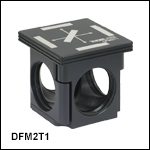
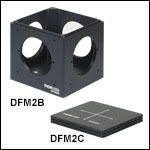
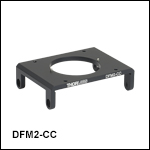
 60 mm Cage Cube for Fluorescence Filter Sets
60 mm Cage Cube for Fluorescence Filter Sets